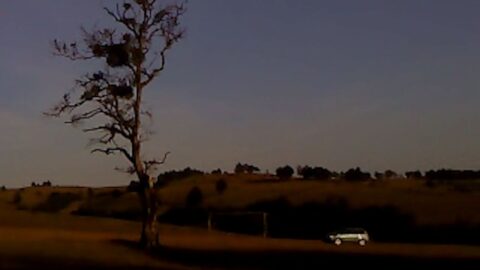Alexandre Koberidze’s third feature, Dry Leaf (2025), is beautiful despite itself. At the least, it demonstrates a unique kind of cinematic rhythm and cadence: while the images themselves are deliberately blotchy and low-res, they cohere to yield a striking, almost transformative, aesthetic world. The film posits that the viewer only needs to see the silhouettes of pristine visions, or absorb obliquely the grand gestures of art, to inhabit some form of sublime experience.
It’s a big, daunting, mesmeric swing.
The opening montage is usefully representative of Koberidze’s abiding visual concerns: bristling trees, sleeping dogs, watchful cats, a statue, a foot on a football belonging to a statue, and — quite pointedly — a dry leaf. The initial setting is Tbilisi, indicated by a passerby asking for directions to Rustaveli Avenue, the home of the national parliament. But what begins there soon sprawls outward, the camera traversing Georgia’s rural landscapes, weaving through the towns and hinterlands, a patient three-hour road trip that foregrounds its ellipses in narrative and caesuras of meaning. The distant perspectives deployed on the undulating countrysides are reminiscent of Abbas Kiarostami’s Taste of Cherry (1997), but perceived through murkier, Dogme 95-style sightlines.
Please, the plot!, you beg. Irakli (David Koberidze, Alexandre’s father) receives notice from his daughter Lisa, a 28-year-old sports photojournalist, that she has run away from home. A newspaper recently dispatched her across the country to document a set of scenic village football pitches. Worried, Irakli enlists the help of Lisa’s colleague, a guy called Levan (Otar Nijaradze), in pursuit of his wayward offspring. Levan, it must be said, is invisible, as are a decent portion of the locals whom Irakli encounters along the way. Again, the viewer is invited to fill in the gaps: what do we need to perceive in order to understand? Tensions between presence and absence are heavily intoned. Offered here, they rearticulate Koberidze’s previous, celebrated work What Do We See When We Look at the Sky? (2021), which, at one point, literally asked the audience to close its eyes.
Dry Leaf poses slightly different but no less challenging questions to the spectator. In a recent interview with Sam Goff for Klassiki, Koberidze emphasised his attraction towards “coincidence;” his latest effort translates this interest into a technical and formal approach to filmmaking. Koberidze’s desire to “let things happen,” to have patience, to wait; it colours his storytelling. Literally, it colours: the blunt shuttering of darkness elides dawn and dusk, occasional shafts of light divide the screen, and a devoted attention to re-presentation iterates the football field, pockmarked by empty, netless goalposts and idle farmyard animals. In this way, Koberidze leans into the traditions of painting. A series of postimpressionist subjects haunt the compositions: Monet’s haystacks, Cezanne’s apples, Van Gogh’s home in Arles. The squinty home-video effect reacts dissonantly with these vibrant hues and alert imageries.
That this production is a close-knit family affair adds another layer of import. Alexandre’s brother Giorgi supplies the music, a mix of electronic and classical tones suggestive of exploration that gives nondiegetic force to successive, tangential sceneries. By casting his father in the lead role, and filming together over several summers, Koberidze imbues the project with both a familial and practical intimacy. (Koberidze senior was the only one with a licence, so he had to do all the driving!) Yet it also charges Irakli’s paternal obligation with an extra pathos, and while much of the dialogue is toneless and stultifying (see naturalistic), it evokes a troubling sense of loss and consequence that is difficult to pinpoint.
What recurs is Koberidze’s deeply earnest love of football, which functions as an emotional resource and cinematic motivation, whether found in the reverent framing of disused pitches or the allusion of the title. Dry leaf refers to a shot that swerves unexpectedly through the air, a knuckleball in Anglo-parlance. That element of surprise is fed through the reverie of the final act, during which the cascading foam of a car wash, and the broken arm on a pair of sunglasses, intersperses with the end of Irakli’s journey. There is a tentative ecstasy to this section, tempered by its apparent mundanity, given definition by a key, unobserved character: “Maybe we’ve seen the same thing.”
Joseph Owen, occasional film critic, is a research fellow at the University of Southampton.

